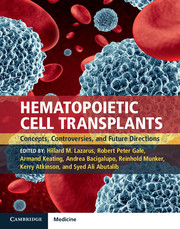Book contents
- Hematopoietic Cell TransplantsConcepts, Controversies, and Future Directions
- Hematopoietic Cell Transplants
- Copyright page
- Dedications
- Contents
- The Editors
- List of Contributors
- Preface
- Chapter 1 A Brief History of Hematopoietic Cell Transplantation
- Chapter 2 Current Use and Trends in Hematopoietic Cell Transplantation
- Chapter 3 Biology: Critical Components of Hematopoietic Cell Transplantation
- Section 1 Recipient Selection for Hematopoietic Cell Transplantation
- Section 2 Donor Selection for Allogeneic Hematopoietic Cell Transplants: A Moving Target
- Section 3 Collecting and Processing of the Graft
- Section 4 Early Post-Transplant Interval
- Section 5 Infections after Hematopoietic Cell Transplantation: Progress?
- Section 6 Late Complications of Hematopoietic Cell Transplantation
- Section 7 Other Complications of Hematopoietic Cell Transplants
- Section 8 Prevention, Detection, and Treatment of Relapse after Hematopoietic Cell Transplants
- Section 9 Selection of Conditioning Regimen and Challenges with Different Types of T-Cell Depletion Methods
- Section 10 Hematopoietic Cell Transplants for Acute Leukemia and Myelodysplastic Syndrome
- Section 11 Hematopoietic Cell Transplants for Myeloproliferative Neoplasms
- Section 12 Hematopoietic Cell Transplants for Lymphomas: Changing Indications
- Section 13 Plasma Cell Dyscrasias: Hematopoietic Cell Transplants
- Section 14 Autotransplants for Solid Neoplasms
- Section 15 Hematopoietic Cell Transplants for Non-Neoplastic Diseases
- Chapter 52 Hematopoietic Cell Transplants for Bone Marrow Failure Disorders
- Chapter 53 Hematopoietic Cell Transplants for Fanconi Anemia
- Chapter 54 Allogeneic Hematopoietic Cell Transplants for Thalassemia
- Chapter 55 Allogeneic Hematopoietic Cell Transplants for Sickle Cell Disease
- Chapter 56 Autologous Hematopoietic Cell Transplants for Autoimmune Diseases: Therapeutic Rationale and Limitations
- Chapter 57 Autologous Hematopoietic Cell Transplants for Autoimmune Diseases: Specific Diseases and Controversies
- Chapter 58 Hematopoietic Cell Transplants for Human Immunodeficiency Virus-Related Lymphomas
- Section 16 Novel Transplant Strategies
- Section 17 Novel Cell Therapies and Manipulations: Ready for Prime-Time?
- Index
- References
Chapter 58 - Hematopoietic Cell Transplants for Human Immunodeficiency Virus-Related Lymphomas
from Section 15 - Hematopoietic Cell Transplants for Non-Neoplastic Diseases
Published online by Cambridge University Press: 24 May 2017
- Hematopoietic Cell TransplantsConcepts, Controversies, and Future Directions
- Hematopoietic Cell Transplants
- Copyright page
- Dedications
- Contents
- The Editors
- List of Contributors
- Preface
- Chapter 1 A Brief History of Hematopoietic Cell Transplantation
- Chapter 2 Current Use and Trends in Hematopoietic Cell Transplantation
- Chapter 3 Biology: Critical Components of Hematopoietic Cell Transplantation
- Section 1 Recipient Selection for Hematopoietic Cell Transplantation
- Section 2 Donor Selection for Allogeneic Hematopoietic Cell Transplants: A Moving Target
- Section 3 Collecting and Processing of the Graft
- Section 4 Early Post-Transplant Interval
- Section 5 Infections after Hematopoietic Cell Transplantation: Progress?
- Section 6 Late Complications of Hematopoietic Cell Transplantation
- Section 7 Other Complications of Hematopoietic Cell Transplants
- Section 8 Prevention, Detection, and Treatment of Relapse after Hematopoietic Cell Transplants
- Section 9 Selection of Conditioning Regimen and Challenges with Different Types of T-Cell Depletion Methods
- Section 10 Hematopoietic Cell Transplants for Acute Leukemia and Myelodysplastic Syndrome
- Section 11 Hematopoietic Cell Transplants for Myeloproliferative Neoplasms
- Section 12 Hematopoietic Cell Transplants for Lymphomas: Changing Indications
- Section 13 Plasma Cell Dyscrasias: Hematopoietic Cell Transplants
- Section 14 Autotransplants for Solid Neoplasms
- Section 15 Hematopoietic Cell Transplants for Non-Neoplastic Diseases
- Chapter 52 Hematopoietic Cell Transplants for Bone Marrow Failure Disorders
- Chapter 53 Hematopoietic Cell Transplants for Fanconi Anemia
- Chapter 54 Allogeneic Hematopoietic Cell Transplants for Thalassemia
- Chapter 55 Allogeneic Hematopoietic Cell Transplants for Sickle Cell Disease
- Chapter 56 Autologous Hematopoietic Cell Transplants for Autoimmune Diseases: Therapeutic Rationale and Limitations
- Chapter 57 Autologous Hematopoietic Cell Transplants for Autoimmune Diseases: Specific Diseases and Controversies
- Chapter 58 Hematopoietic Cell Transplants for Human Immunodeficiency Virus-Related Lymphomas
- Section 16 Novel Transplant Strategies
- Section 17 Novel Cell Therapies and Manipulations: Ready for Prime-Time?
- Index
- References
- Type
- Chapter
- Information
- Hematopoietic Cell TransplantsConcepts, Controversies and Future Directions, pp. 552 - 558Publisher: Cambridge University PressPrint publication year: 2000

